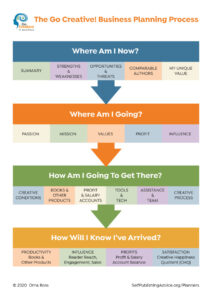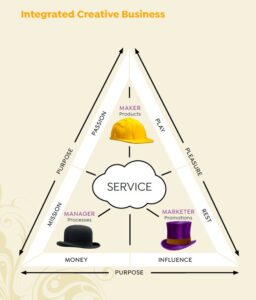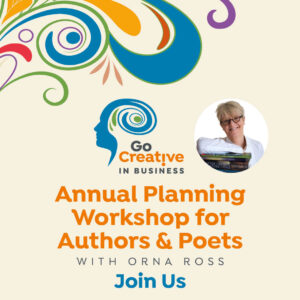How was your 2021? Do you want to have your best writing and publishing year yet in 2022? Orna Ross uses a particular planning method that integrates all the aspects of a writing and publishing business, fosters creative flow, and keeps overwhelm away. Here's an overview of this G0 Creative! planning program for indie authors– PLUS some Alliance of Independent Authors members discuss their own planning methods.

Orna Ross, Director of ALLi
As a director of ALLi, I see every day how many author-publishers are working hard but barely inching forward.
Maybe they can't finish their first or final draft of their book. Or their books are not selling. Or they don’t pay themselves a salary, or even have enough money for their tax bill. Maybe they're seeing improvement, but they are constantly stressed.
It’s not surprising that self-publishing can sometimes feel stressful or overwhelming. Creative businesses are challenging.
To succeed as a working indie author, you must not just write and publish well, two complex skills which take years to learn, but you must fulfil or exceed the expectations of your readers and followers, not just once but again and again.
And you must do all this at a profit, so that everyone associated with your publishing business—including you—gets properly paid.
It's not just that you have many tasks multi-faceted tasks to do. You also have to balance the commercial with the creative.
Your passion for writing, and your sense of mission and purpose as a writer, drives your author-publishing business, as much as your need to make it profitable.
To get where you want to go–as a writer, as a publisher–you are going to have to grow, expand, evolve. Growing pains are inevitable.
They don't have to derail you, though. And they won't, if you have a proper creative publishing plan in place and you know how to work it.
Go Creative! Business Planning for Authors and Poets
A successful author is a productive author. A successful publisher is a profitable publisher. Yet most indie authors approach their business planning armed with little more than a to-do list and are surprised when they struggle to get on top of things.
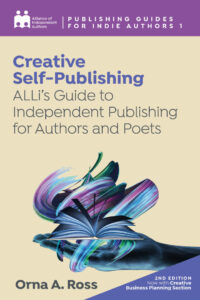
A list is better than no written plan at all but if we're using nothing but a list, without a contextual framework, it can leave us feeling stressed out and incomplete, with no sense of accomplishment except on the big milestones: finishing the first or final draft, publishing the book, or hitting a bestseller list.
That's how I used to do it. That to-do list was always there. I'd take it to bed at night and there it would be, when I'd get up in the morning, calling me to add a few more tasks.
I got things done, and would get a rush of achievement every so often, but I never felt like I was on top of it all. I tried other planning methods, but I found them too mechanistic. They didn't allow for the intuitive and messy side of creative work.
What I needed was a planning method that integrated the three aspects of the job–writing, publishing and business–into one well-honed creative enterprise. Over the years, I developed my own method, an approach based on my own experience as a writer and publisher but also on everything I'd learned about in my previous life as a university teacher of creative and imaginative practice, and my current role as director of ALLi.
A while back, I shared these planning principles and practices with a small group of authors, through my creative planning program on Patreon, and found it works for others too.
I have now updated a second edition of my book Creative Self-Publishing, with a section about this planning program, which I call Go Creative! Business Planning for authors and poets.
Annual Planning for Authors and Poets: The Go Creative! Program
Like most planning systems, this program for authors and poets begins with framing creative intentions and goals for the year ahead, then breaks these down into smaller goals and intentions.
It divides the year into four quarters, each quarter into three months, each month into four weeks, each week into six working days, and each day into hours–until you are clear about the tasks you have to do in the time available right here, right now.
Whether you're planning the year or the day ahead, or anything in between, there are four key planning questions:
- Where am I now?
- Where am I going?
- How am I going to get there?
- How will I know I've arrived?
1. Annual Planning: Where you are now?
Review the previous year. Consider the strengths and weaknesses, opportunities and threats your author-business is facing. Also, what unique value are you bringing to readers? What is it about your books that makes them valuable to another?
Finally, if you haven’t already, compile a list of comparable authors and think about your own work compared to theirs–not in any hierarchical way but at the level of offering.
- What do they offer the engaged reader?
- How does that compare to your offering?
- What’s not out there that you feel compelled to write? (Hint: this will be connected in some way to your early life experiences).
- What can you learn from their book descriptions, covers and reviews?
2. Annual Planning: Where are you going?
What are your creative intentions for the year ahead? What goals will best feed your personal passion, mission and values, as well as being most likely to deliver the profit you’d like to make, and the reach you’d like to have in your genre and niche?
3. Annual Planning: How are you going to get there?
The internet is full of writers counting words and yes, getting our writing done is vital, but it’s only one strand of success for an indie author, who is also a publisher. What are the best processes for you to achieve what you want to achieve–not just in writing, but also in your publishing, in your author-business?
When thinking about the year ahead and what you want to achieve, plan the tools and technology you'll use to achieve your goals, and the publishing team you'll need (editors, designers, and formatters, assistants).
- What creative conditions do you need to set up for yourself?
- What is the optimal ecosystem of books and other products to produce the most profit while satisfying your creative passions?
- How much time and money will you need to invest? What sort of return can you realistically expect?
- What about other resources?
Keep things as simple as possible as you plan how you'll optimally harness your time, money, and resources. Slow down and take it easy. Be realistic and be kind to yourself. Pushing, forcing, harassing ourselves–these usually have the opposite effect to what we intend. Little and often is the best way to go.
I have found it helpful to recognize that author-publishers must wear three very hats to do our very diverse work and tasks: that of the maker (writing words and producing books), manager (improving processes and profits) and marketeer (promoting books and other products and projects).
Knowing which hat does what, and understanding our own creative process and cycles around each of these roles, helps us to make good plans, to understand what we need to do in order to move to the next step, or next level, in harmony. The three hats give us a way to integrate all our tasks. [more on the three hats below]
4. How will you know when you’ve arrived?
You’ll be measuring. As well as you having your particular, personal definition of success, there are universal measures for all indie authors, four key indicators of a healthy author-publishing business. They are productivity, platform, profits, and personal satisfaction.
- Productivity: Your output. Expressed as words completed (writing productivity) and books published (publishing productivity).
- Platform: Your influence and impact. Expressed as reach and reader engagement (book sales, follower numbers, purchases and other publications).
- Profits: Your financial rewards. Expressed as money paid across to you after all your publishing expenses are met.
- Personal satisfaction: Your pleasure in your work. Expressed as a reading from one to ten based on internal self-observation, one being misery and ten creative bliss—your creative happiness quotient (CHQ).
The Go Creative! business planning program brings you back, again and again, to these measures, particularly to that fourth and most important measure: your CHQ: is what you’re doing, and how you are doing it, making you happy? How happy, on a scale of one to ten?
The two outer measures of productivity and profit tell us what we’re creating, while the two inner measures of purpose and personal happiness connect us to how we’re creating. It’s good to have an end in mind but, in the end, what counts for a creative is how you go.
The intention here is to go creative each step of the way.
Annual Planning for Authors and Poets Principle 1: Three Hats
The framework that we often carry in our minds makes our writing and publishing oppositional. We see writing as creative and worthy but marketing and promotion as commercial and a bit crass.
This mindset is unhelpful. It's also inaccurate. Writing can be a dry and joyless rote activity and marketing can be highly creative. It ain’t what you do, it’s how you do it.
The best way to get beyond this duality is to understand that your work has three aspects and to imagine yourself donning the three different hats of maker, manager and marketeer. for those three different roles.
In order to understand and integrate them, let’s first separate them out by imagining ourselves donning and doffing each role as if it were a hat.
- You put on your Maker Hat for the work you do in your business, making the products you sell and the materials that help you to sell them. Your key Maker task is production—writing words and creating books and other products from those words. You may also make audio and video as part of your creative mission and to promote your books.
- You put on your Manager Hat for the work you do on your business: as you harness time and money, tools and team into making and selling your products. Your key Manager task is processing—actioning, organizing, improving, maximising.
- You put on your Marketeer Hat for the work you do to grow your business, as you pitch, publicize, and partner with others to reach more readers and sell more books. Your key Marketeer task is promotion—attracting readers with compelling content and communications that bring them to buy.
When we think of ourselves as Makers, Managers and Marketeers, rather than just writers who publish, we can see more clearly what the job of being an indie author actually asks of us, day by day, week by week, month by month. Now it all begins to hang together and to make more sense.
Let’s a little more closely at what's under these three hats: how Maker, Manager and Marketeer think—what they believe, how they spend time, what they need to watch out for, and what they most want.
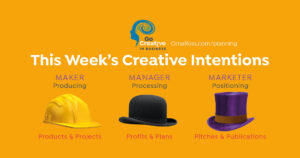
The Maker’s perspective focusses inwards. Wearing this hat, we see our creative business primarily as a system that allows us to make stuff. We have a list of tasks we need to do in order to make our books and related products.
- The Maker craves creativity itself and the solitude and space to create.
- Main Occupational Hazard: Failing to recognize the role of the Manager and Marketeer
The Marketeer’s perspective focusses outwards. Wearing this hat, we see the business as a system for turning ideas into ever-expanding value. Our sights are on partnerships and projects that enable us to grow. Our aim is to become a prominent author in our genre.
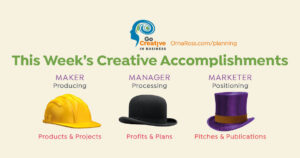
- The Marketeer craves influence and impact, to be seen and heard.
- Main Occupational Hazard: Prioritizing other people’s opinions
The Manager's perspective takes a holistic focus. Wearing this hat, we see our business as a system that delivers profit and pleasure to ourselves, our readers, our team, and our partners– everyone who touched by our author business.
- The Manager craves order and security, to be organized.
- Main Occupational Hazard: Rigidity. Forgetting to make it fun.
Annual Planning for Authors and Poets Principle 2: Creative Rest and Play
Also, for a creative, rest and play are not breaks from the process. They are the process. You need time and space to switch off and relax, to explore and experiment and express, to mess about.
Neuroscience confirms what creatives of all kinds have always known: the best ideas surface more often during down-time. In any successful creative project, whether or not we realize it, the subconscious mind has done most of the heavy lifting. Most of the fretting and feelings we brought to the project had very little to do with getting us from desire to done.
The accomplished creative can hardly tell work from rest and play. What distinguishes them is that creative rest and play are even lighter and freer than creative work, because they have no end goal. We pursue them purely for their own sake.
Play can be swings, comedy, puzzles, flirting, cartwheels, dressing-up, daydreaming, ping-pong or other (non-competitive) games, parties, trampolines, cards, shooting hoops, coloring… There are a thousand ways to play, so long as it’s freely chosen and your idea of fun.
Rest too is key activity for a creative.
When you rest and play, you ignite the creative centers in your brain. You silence your self-censoring, inner critic. You see your challenges through a fresh lens and creative solutions rise and present themselves, seemingly unbidden.
For the creative, rest and play renew us. Re-create us. And certain kinds of rest and play are more enriching than others, more likely to foster flow.
- Rest that optimises flow state is all about giving your thinking mind a rest. This is best achieved through mindfulness, which is about consciously immersing oneself completely in the moment and not thinking about past or future, or meditation, which uses a single point of focus to still the mind.
- Play that optimises flow state is all about activities that are slightly hypnotic and rhythmical, that induce a slight trance state. Particular kinds of repetitive, rhythmical, physical activities like aerobic exercise (jogging, walking, swimming, dancing) are great for writers, who spend so much time sitting at a computer.
Creative rest and play are most effective when we are intentional around them, when we relishing the contrast and recognise its value, rather than thinking we should be doing something more “productive”.
That's why effective creative business planning factors time for rest and play, alongside the creative work.
Annual Planning for Authors and Poets Principle 3: Pay Yourself First
The “pay yourself first” principle was coined in the 1920s by another indie author, George Samuel Clason, a publisher of maps and writer of nonfiction handbooks, including a series of self-help books that delivered financial wisdom through parables set in ancient Babylon, with names like — Seven Cures for a Lean Purse and The Five Laws of Gold.
In 1930, Clason compiled and self-published his parables in The Richest Man in Babylon2, a book that has sold more than two million copies in 26 languages. “The secret to personal financial success,” he told his local newspaper, “is believing and practicing this axiom: Part of all you earn is yours to keep.”
Your intention to be a successful business owner begins with the action of paying yourself first. Your business plans should encourage that to happen.
Using the Go Creative! planning method, you divide your income four ways in your mind: profit, salary, tax and what's left in your income and expenses account is then free to spend on the business.
Twice a month, you pay over the percentage you’ve allocated to those three accounts. Now you can see how much money your business actually has to cover its expenses.
Why not monthly, or weekly, or as needed? By allocating your accounts and paying your invoices twice monthly you get the benefits of batching, which is more efficient. It also allows you to stay in touch with your accounts at a rate in which you can see what’s really going on with cash flow. It’s the perfect balance between constant checking, which wastes time, and doing it too rarely to pick up on trends.
I do mine on the 5th and 20th of each month, and the Go Creative! business planning sheets use those dates, too.
Go Creative! Business Planning Workshops
The Go Creative! Planning Program and it needs to be experienced, not just read, in order to benefit from it.
Each month, I offer a workshop to my creative business planning patrons. These workshops are not for everyone, as they take a particular approach centered on your own creativity, your own definition of success, and your personal passions as an author and publisher.
They encourage you to go deeper and harness your creative capacity, so you can achieve more by doing less.
We do the work, there and then in the workshop, so each month you leave with a completed plan and a clear vision for your next steps.
These are not large webinars/podcasts with thousands of attendees but small-group, guided events. I limit places so you receive personal attention and feedback during the workshop–and through the month in Patreon.
Your payment covers access to replays of all previous workshops, as well as the current one live–and a variety of other resources, including
- Accountability group
- Downloadable PDFs of intention maps, accomplishment logs, and other Go Creative! worksheets, tools, and planners
- Replay videos so you can refer back any time
- Mid-month motivator
Alternative Business Planning
Having said all of that, planning doesn't work for every brain and personality–and that's okay. If you need permission not to plan 2022, you have it.
Maybe you prefer a task list instead or a timeline? Or maybe you just like to go with the flow? The brilliance of being an indie author is that you get to create your business around you. Your strengths, your loves and desires.
ALLi's news editor, Dan Holloway, recently discussed the issues around planning when you're neurodivergent in the ALLi member forum. Dan said:
“One of the things struggling for 40+ years with conventional techniques as a neurodivergent person has taught me is that it is essential to develop a system that works for you. For me, that means finding a very simple, visual way of tracking all the progress I need to as well as a granular day by day set of related tasks.It has to be analogue and it has to be visible from my desk, because the “object impermanence” associated with my ADHD means that anything hidden in a file or inside the covers of a book or on a phone/computer might as well not exist; and I have to be able to literally “download my brain” to the system – that is, ANY task that needs doing has to be written down so I never have to rely on memory or habit – that's the only way I can free up my brain to tackle the actual creative work.Post-its are a no, because they go missing. Basically, all the tools people with different neurotypes swear by are useless – but once I realised that it was remarkably freeing–and enabled me to look at what would work.
Needless to say this process has made me realize there is a gap in the self-help market that I'm writing a book to fill!!”
Other Member Planning Methods
Michelle Hanton
“December is a great time to plan/revisit. I use a strategic plan – set for 3 years at a time – not one of those boring corporate tomes but a 2 pager that shows me what, how and when. From that comes the SMART goals to meet my KPI'S. Review twice a year, in June and December. Trello is my friend plus a physical diary and a physical notebook.
For instance the recently published book was broken down into a 6 month SMART goal. KPI was 300 pre-sales. Smashed it with 600.Got pics if you are interested as I do run a workshop on strategic planning and my new goal for 2022 is to tweak it to offer one specifically for indie authors.
Mistakes and lessons learnt – you absolutely need to have clarity and that comes with setting end goal first and breaking down into smaller ones. Measuring progress helps you keep motivated as you tick things off. Too often we neglect to look at how far we have come.”
Tiara King
“Mine is a multi-step plan and I start the first few days of January when the public holidays are on so I have the peace and quiet. I usually grab a pile of note paper and write down a list of everything I want to do in that year by subject and author/business name, and add everything else I need to pay for, do, appointments, etc. I then divide all of that by month, by taking another twelve pieces of paper and writing everything out monthly.I used to do a neat version for each month, with everything in order, to add to the planner. I’ve been using a brand called Happy Planner for the last few years, but moving forward I’m going to reorganize everything to not need a full year planner. I would set up the planner and mark off the school and public holidays, plus December and January. The weeks that are left I map out blog posts and when I want to publish a book, plus any blog posts related to it.
And finally, once each month rolls around, I make weekly lists so I can focus solely on what needs to be done that week, otherwise I’m looking at everything for the month or year and will want to do everything else instead of what needs to be done now.Back in 2015/16 I did a quarterly list and layout, but that waned after a couple of years as I got into the Happy Planner. I’ve gone back to the layout this year so I can see what I need to do for a full year in one place, and then have quarterly lists as well so I can focus solely on three months at a time. I often write out daily or weekly lists, just so I can get something done. That’s the way I’ll be moving forward. I also want to release three books next year, so next year’s list will be a big one.”
“Last year was the first time I did it properly, spent most of December handwriting in my journal, everything I needed to sort in my life – health, relationships etc – in order to develop this new career as a self-published author. This year I'm writing it up as a set of free daily emails to the wannabe comedy writers on my email list. In the same way that they are starting out as comedy writers and coming to me for advice, I'm starting out as a novelist and self-publisher, so everything I'm trying comes from a similar place of not yet being a part of the professional community. I'm just thinking now about my main goals for 2022, related to health and working practices, both of which help to set the tone for the career goals. I think you can have career goals without health goals but unless you're in the right physical and mental space then it'll be harder to achieve them. Especially to avoid burn-out!”
Meg Jolly
“I start planning around nov every year. I use www.yearcompass.com to review personally and professionally — it's a really handy tool that works for me. It also helps nail some of the big picture visions for the year ahead personally and professionally. I prioretise mental and physical health, and my young family, just as much as my writing career right now.
I use a planner (bullet journal, though for 2022 I'm trying a Clever Fox planner) to transpose any key dates from my calendar (holidays, other big commitments) and loose/firm publishing goals…whatever I know really! And then..fill in the gaps. (I always change course as needed and it's not carved in stone though).
I use quarterly planning to get my monthly goals (which I then break down into weekly and daily tasks). I try to align it so that no matter how micro or macro I look, everything I'm doing is contributing to the bigger picture, and I review this weekly on a smaller level and monthly/quarterly on a higher level. Anything superfluous gets cut. I don't have time to waste.”
Annual Planning for Authors and Poets: Resources
- More about Orna's Go Creative Planning Program for patrons here
- Details and registration for Orna's next workshop here
- Joanna Penn's Your Author Business Plan book and workbook are in Joanna's shop here.
- 2021's Twitter Chat on planning hosted by Tim Lewis, is here.
- Your Author business plan post here.

